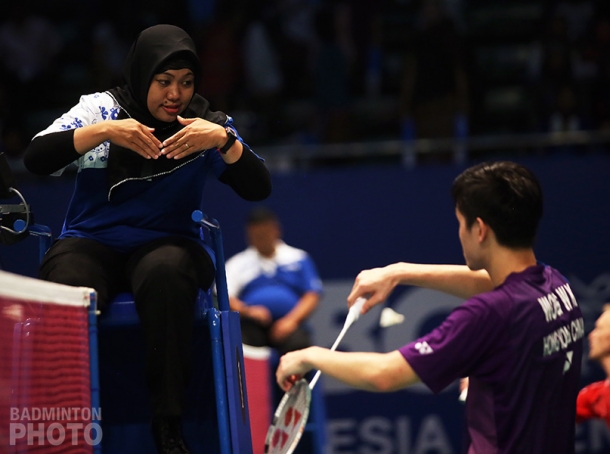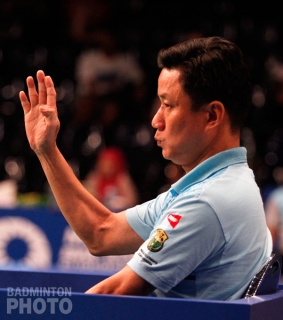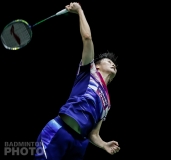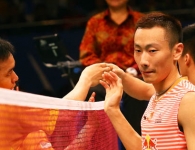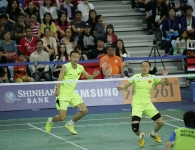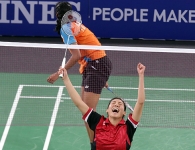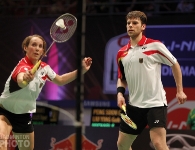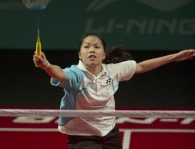The BWF finally plans to test out a new rule to standardize both service height and the judging thereof. But is it really going to solve the problems that need solving? We ask you to vote on it in our newest Badzine Poll!
We’ve all seen it while watching badminton broadcasts. Play stops seconds into a rally, sometimes with a smasher poised in mid-air. The umpire announces, “Service fault called.”
Then what seems to happen at least 70 percent of the time is that the player turns or walks to the service judge – or possibly asks the umpire’s permission to do so – and pantomimes the illegal service motion they are convinced they didn’t do.
Obviously, there is a problem. Every server faulted insists that they have been serving the same way all match. Some players feel they can’t flick for fear of being faulted for service height or shaft angle. Others appear to have decided they have to flick to avoid facing the flub-it/fault-it/eat-it trilemma plaguing the doubles service situation. The faults often come at the most crucial moments. Court officials maintain that end-of-game tensions lead to players pushing the boundaries in order to avoid giving away the advantage at the beginning of a crucial rally.
Late last year, the Badminton World Federation (BWF) finally announced an experimental change to the rule governing the height of the service, fixing it at 1.15m and replacing the old rule, which said “the whole shuttle shall be below the server’s…bottom rib”. The new rule will get its first test at the All England this coming March but the old rule will continue to be used at events like the World Juniors, and presumably any event not rated high enough to get the new measuring devices. Men’s singles world #1 Viktor Axelsen has famously lampooned the new rule, including with a video of himself and team-mate Mads Pieler Kolding attempting to serve from below 80cm. Many players under 1.75m may welcome the rule after years of being prohibited by the existing rules from striking the shuttle at the same height as taller players. Axelsen has also questioned the advisability of beginning testing of the rule at an event as important as the All England.
Questions about how the rules or their enforcement should be changed are not new. At Badzine, we ran a feature back in 2010 where BWF umpire Michaela Bencová laid out several of the options and one of these has become the new experimental service law. The service height is only one question, however. While viewers are rarely afforded a camera angle on a television replay that is sighted directly at a professional server’s bottom rib, replays routinely reveal the errors of service judges who have ruled that shuttles were struck with an upwardly-angled racquet (rule 9.1.7). The new rules, rather than addressing any possible inconsistencies in the judging of whether a shaft is pointing in a downward direction, state that the 1.15m height restriction will obviate rule 9.1.7 altogether. Another proposal mentioned by Ms. Bencová was removing the back doubles service line. This might relieve some of the pressure that doubles players feel to serve as flat as possible and certainly, service fault calls are less common in singles matches. However, changing a long-standing rule like that will likely have its own opponents and with so many flick serves being called for violations of Rules 9.1.6 and 9.1.7, increasing the incentive to serve high will not necessarily be a complete solution.
The BWF announcement does not make it clear but it could be that the world body has decided that the fixed height was the only way to introduce precision and consistency. In other words, automation of finding and using individual players’ bottom ribs as a reference point may have been deemed infeasible, although it was one of the options mentioned by Ms. Bencová in her article. However, unlike the review system for line calls, which have no effect on the mechanics of how players hit shuttles toward the side and back lines, implementation of the fixed height service rule mean that players will have different allowable heights and shaft angles depending on what technology is available to a given tournament’s court officials. After all, asking a service judge to eyeball 1.15m without specialized equipment would be even more unrealistic than asking them to consistently sight a shuttle relative to a bottom rib.
We ask you to cast your vote in the poll below, on whether you think the new rule is the one we need. You can choose up to two options and feel free to expand on your selection by contributing to the comment section at the bottom of this page.
Photos: Badmintonphoto
[poll id=”37″]
![POLL – How can we be of service? The BWF finally plans to test out a new rule to standardize both service height and the judging thereof. But is it really going to solve the problems that need […]](http://www.badzine.net/wp-content/uploads/ngg_featured/20160601_1016_IndonesiaOpen2016_BP__4554.jpg)
